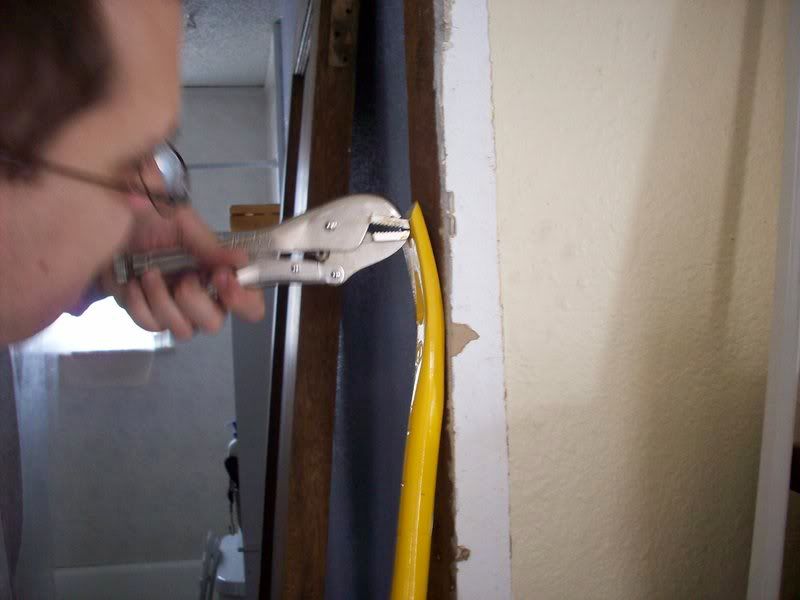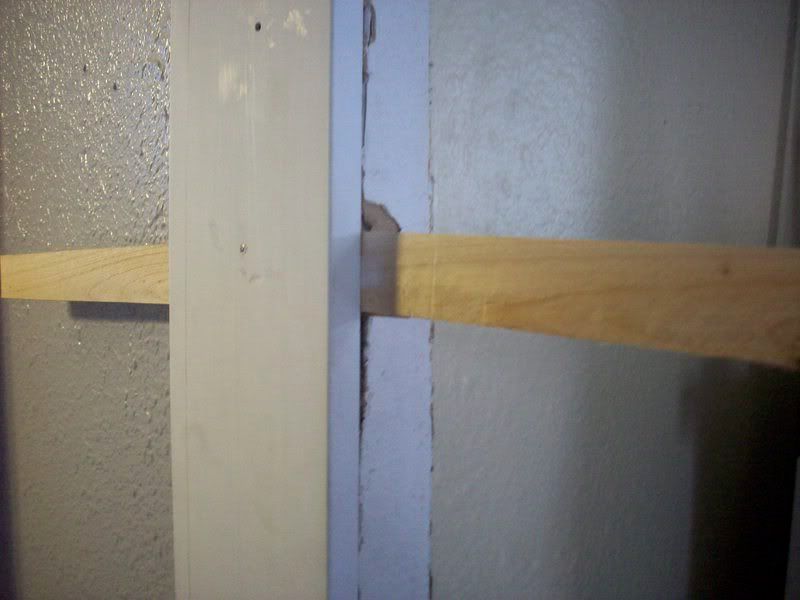Level and plumb your jambs INCLUDING the header before you nail it into the wall. If you don't, your work is futile.
We didn't. Well, I thought I remembered doing it, but it was VERY obvious that we did NOT plumb or level the jamb. We hauled our 50 or 60 lb door (sorry Karen of Delano Bungalow... we don't know if it rivals yours as neither of us could hold it by ourselves!) into position, using shims to brace it up off the floor. Then, we noticed that the jamb was NO WHERE near square. Sigh.
We pried off the door jamb, and made sure it was square with itself and plumb. We discovered that the finish nails we used did not want to come out of our steel-like 100 year old wood studs, and came up with this ingenious solution:

Vise grips holding the nail head, with a crowbar doing the prying using the vise grips as a de facto head.
We discovered that our wall is actually no where near plumb, which is what caused us to hang our jamb off of plumb. I would say it's about 5º off.
We used shims to set the jamb in a square and plumb fashion,

making sure to use two shims each time for stability.
The jamb is now square and plumb... but it sticks out over the drywall in places and doesn't cover the stud in others. It's essentially at a diagonal to the stud. I don't know if this is OK at all... but we decided to go ahead.
Measure twice, measure again, and THEN cut. Then, measure again. It might have moved.
We measured once. We are sorry excuses for home improvers. We measured the distances for our mortises onto the jambs once, and then set at it with chisels. We chipped out perfect mortises, screwed our jamb side hinges in, and proceeded to attempt door installation.
It didn't fit. The bottom hinge was approximately 1/8 inch too low. Back to the drawing (measuring) board.
Buy good screws... NOT the cheap zinc ones.
We used wood screws we had lying around. They were zinc screws, 2-1/2 inches long. They seemed perfect for screwing the hinges into the jamb and stud.
They were not.
We discovered the jamb hinges were too far apart after many attempts at sliding it in. We did rest the entire weight of the door on the bottom hinge at one point. When we gave up and started to remove the bottom hinge to move it, we were dismayed to find that the screws had snapped off. Only the heads and about 1/4 inch could be removed from the walls. Panic set in...
We went to a big box store and broke our pledge by buying a hole saw. The new plan is to remove the screws in 3/4 inch plugs, and then fill in the holes in the studs with 3/4 inch hardwood dowel. See any problems with this?
Can you help me?
1) Should we hang the door jamb as planned, 5º off of the rest of the wall?
2) Should we remove the 2 snapped off screws using the hole saw and plugged with dowel, or is there a better way?
3) What screws should we use that will support this huge heavy door? I don't trust the zinc wood screws since they already snapped off.

7 comments:
I'm really no help, I'd start again from scratch but I'm guessing someone with more knowledge would tell you how to finangle it. Email Petch House, The Old Crack House, or the Devil Queen, they seem to know what they're doing.
On another topic, I added ome tags, including a houseblogger tag: FSTAG to this post. Hope that's ok with you
Hey! Congrats on the FSTAG! As soon as I figure out how to do it, I'll tag it as well!
As always, I love your posts!
Well, I can't help you with the first two, but you should be able to get screws made out of just about anything from hardened steel to titanium if that's what floats your boat.
If they don't have them at the local hardware, check a website like mcmaster-carr or something. There should be spec sheets for an assortment of materials.
We used that site to order raw materials for a robotics project in college. We were mostly ordering odd sized machine screws and blanks of esoteric materials, but I'm pretty sure they had wood-type screws there too.
Hanging doors. Right. You know, there is no way to explain it in only two paragraphs. Everything that can go wrong DID go wrong. I usually curse my way through this job! But now that you know how....grin!
I tend to start with the hinge on the door rather than the other way around, and I use fat phillips headed (or Robertson headed) galvanized screws.
Fish the broken screws out of their little holes with vice grip pliers. You could fill the holes with glue soaked steel wool. Seems to work for me. But that may not be required if you will be using exactly the same hole again. It can be re-used. A dowel glued down into a drilled hole would just split when you go to use it again, and fail to hold a screw.
I normally support doors on shims placed point over point, and mark through the holes in the hinges. After doing all the rest of the stuff of course.
If the door is really all that heavy, then as soon as feasable, put in an extra couple of hinges.
I'm afraid I have no help to offer, just wanted to acknowledge how brave you are for doing this at all! I'm a coward, but I guess I can fail at things and try again as well as anyone.
Susan
1) Should we hang the door jamb as planned, 5º off of the rest of the wall?
Yes - You can use a small block plane to shave the high spots of the jamb. You can use a utility knife to trim the plaster or drywall where the jamb is low. Do all this when fitting your casing/trim. If you are painting things use a little painters caulk to finish up the joints where the casing meets the jamb and the casing meets the wall.
2) Should we remove the 2 snapped off screws using the hole saw and plugged with dowel, or is there a better way?
DONT use the hole saw. Your dowels will not work properly because your screws would be going into end grain which is a bad idea. Remove the hinge and use some needle nose locking pliers to remove the broken screws if you can. If you cant. Move the hinge up, or down, a quarter inch and start again. That may look like crap though. You could maybe dust try drilling out the screws but that can be tricky. You might be better off replacing the jamb.
3) What screws should we use that will support this huge heavy door? I don't trust the zinc wood screws since they already snapped off.
The screws shouldn't have snapped off. I assume they did during installation, not from the weight of the door. That indicates you did not have a proper pilot hole or you over tightened them. Brass screws are even more prone to this but should hold the weight. Just use any ole wood screw that properly fits the hinge, is the correct length and matched the hinge material (brass, stainless or whatever)
Visit http://www.handyguyspodcast.com if you have any questions. We will be glad to help.
This post terrifies me, as I plan to strip and refinish all my doors this summer. I hope that removing them, removing the hinges, and then putting everything back where it came from will be easier.
It will be easier, right???
Post a Comment